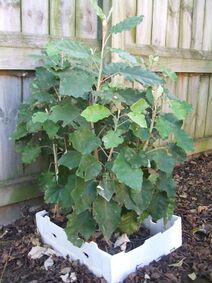Brachyglottis repanda
| Brachyglottis repanda | |
 | |
| Light: | |
| Moisture: | |
| Hardiness: | 9 |
| Soil pH: | 5.6-8.4 |
| Evergreen | |
| Height: | 20' |
| Width: | 20' |
| Speed: | Slow |
| Blooms: | Mid Spring-Late Spring |
| Native to: | |
| Edible Rating: | |
| Medicinal Rating: | |
| Tea: | Yes |
Brachyglottis repanda (common name: bushman's toilet paper)
Propagation: Seed - we have no information on this species but the seed is probably best sown on the surface of a freely draining compost in the greenhouse as soon as it is ripe. Stored seed can be surface sown in the greenhouse in early spring. Do not allow the compost to dry out. When they are large enough to handle, prick the seedlings out into individual pots and grow them on in the greenhouse for at least their first winter. Plant them out into their permanent positions in late spring or early summer, after the last expected frosts.
Cuttings of half-ripe wood, July/August in a frame[1].
Cuttings of mature wood of the current season's growth, November in a frame[2]. Very easy[3].
Cultivation: Requires a good well-drained loamy soil in a sunny position[3][2] or partial shade[4][1].
Plants are quite frost-tender and only succeed outdoors in Britain in the mildest areas of the country[3][2].
Some named forms have been developed for their ornamental value[4]. The flowers emit the sweet scent of mignonette, this is most pronounced at eventide[5].
Range: New Zealand.
Habitat: Coastal to montane forest and scrub[6].
Edibility: A gum is obtained from the plant and is used for chewing[6]. It should not be swallowed[6], however, and in light of the warning on toxicity at the top of the page, perhaps it should not even be chewed[K].
Medicinal: A gum obtained from the plant is chewed to sweeten the breath[6].
Usage: The plant has large sage-green leaves with a white, hairy underside[5]. They are used as a substitute for toilet paper.[6]
Pollinators: Insects
Soil: Can grow in light, medium, and heavy soils.
Drainage: Prefers well drained soil.
In Leaf: Evergreen
Flower Type: Hermaphrodite
Known Hazards: All parts of the plant are poisonous[6].
Also Known As: Cineraria repanda. Senecio forsteri. S. georgii.
Links
References
- ↑ 1.0 1.1 Brickell, Christopher. The RHS Gardener's Encyclopedia of Plants and Flowers. Dorling Kindersley Publishers, 1990.
- ↑ 2.0 2.1 2.2 Huxley, Anthony. The New Royal Horticultural Society Dictionary of Gardening. MacMillan Press, 1992.
- ↑ 3.0 3.1 3.2 Chittendon, Fred. RHS Dictionary of Plants. Oxford University Press, 1951.
- ↑ 4.0 4.1 Thomas, Graham. Ornamental Shrubs, Climbers and Bamboos. Murray, 1992.
- ↑ 5.0 5.1 Genders, Roy. Scented Flora of the World. Robert Hale, 1994.
- ↑ 6.0 6.1 6.2 6.3 6.4 6.5 Crowe, Andrew. Native Edible Plants of New Zealand. Hodder and Stoughton, 1990.